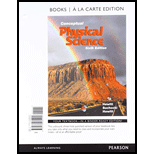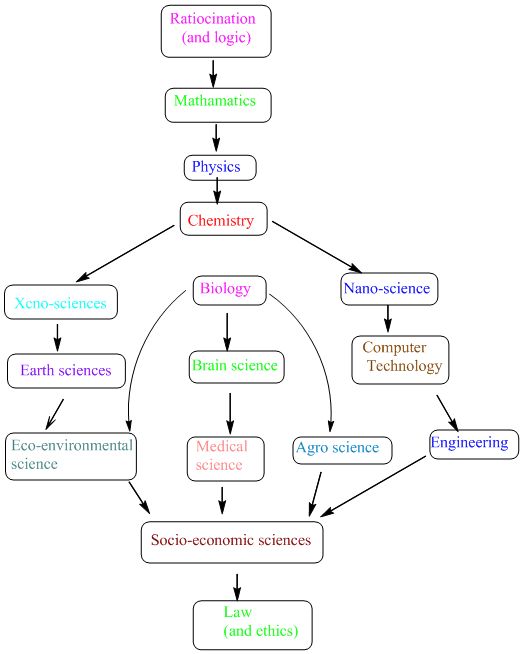
Conceptual Physical Science, Books a la Carte Edition; Modified Mastering Physics with Pearson eText -- ValuePack Access Card -- for Conceptual Physical Science (6th Edition)
6th Edition
ISBN: 9780134466927
Author: Paul G. Hewitt, Leslie A. Hewitt
Publisher: PEARSON
expand_more
expand_more
format_list_bulleted
Question
Chapter 14, Problem 1RCQ
To determine
To explain why Chemistry often called central science.
Expert Solution & Answer
Answer to Problem 1RCQ
Solution
Chemistry is called central science because it is connected to all science fields.
Explanation of Solution
Chemistry: Chemistry is a branch of science which deals with the composition of substance, exploration of their properties, reaction and its uses.
Chemistry is a branch of science. Sometimes called as ‘central science’ because it is need to other science field such as, Biology, Physics, Geology, Astronomy, Medicine, Engineering, Material science, etc.

Want to see more full solutions like this?
Subscribe now to access step-by-step solutions to millions of textbook problems written by subject matter experts!
Students have asked these similar questions
Discuss the differences between the Biot-Savart law and Coulomb’s law in terms of their applicationsand the physical quantities they describe.
Explain why Ampere’s law can be used to find the magnetic field inside a solenoid but not outside.
3. An Atwood machine consists of two masses, mA
and m B, which are connected by an inelastic cord
of negligible mass that passes over a pulley. If the
pulley has radius RO and
moment of inertia I about its axle, determine the
acceleration of the masses
mA and m B, and compare to the situation where the
moment of inertia of the
pulley is ignored. Ignore friction at the axle O. Use
angular momentum and torque in this solution
Chapter 14 Solutions
Conceptual Physical Science, Books a la Carte Edition; Modified Mastering Physics with Pearson eText -- ValuePack Access Card -- for Conceptual Physical Science (6th Edition)
Ch. 14 - Prob. 1RCQCh. 14 - Prob. 2RCQCh. 14 - What pledge has been made by members of the...Ch. 14 - Prob. 4RCQCh. 14 - Prob. 5RCQCh. 14 - Prob. 6RCQCh. 14 - How are the particles in a solid arranged...Ch. 14 - How does the arrangement of particles in a gas...Ch. 14 - Which occupies the greatest volume: 1 g of ice, 1...Ch. 14 - What happens to the chemical identity of a...
Ch. 14 - What is a physical property?Ch. 14 - What doesnt change during a physical change?Ch. 14 - What is a chemical property.Ch. 14 - W hat is a chemical bond?Ch. 14 - What changes during a chemical reaction?Ch. 14 - Why is the freezing of water considered to be a...Ch. 14 - Prob. 17RCQCh. 14 - Why is the rusting of iron considered to be a...Ch. 14 - Prob. 19RCQCh. 14 - Prob. 20RCQCh. 14 - How many atoms are in a sulfur molecule that has...Ch. 14 - What is the difference between an element and a...Ch. 14 - How many atoms are there in one molecule of H3PO4?...Ch. 14 - What does the chemical formula of a substance tell...Ch. 14 - Prob. 25RCQCh. 14 - Prob. 26RCQCh. 14 - Prob. 27RCQCh. 14 - What is the chemical formula for the compound...Ch. 14 - Why are common names often used for chemical...Ch. 14 - How soon will nanotechnology give rise to...Ch. 14 - Prob. 31RCQCh. 14 - Who is the ultimate expert at nanotechnology?Ch. 14 - While visiting a foreign country, a...Ch. 14 - Of physics, chemistry, and biology, which science...Ch. 14 - Is chemistry the study of submicroscopic,...Ch. 14 - Prob. 47ECh. 14 - Prob. 48ECh. 14 - Which has stronger attractions among its...Ch. 14 - The leftmost diagram below shows the moving...Ch. 14 - The leftmost diagram below shows two phases of a...Ch. 14 - Prob. 52ECh. 14 - A skillet is lined with a thin layer of cooking...Ch. 14 - A cotton ball dipped in alcohol is wiped across a...Ch. 14 - Prob. 56ECh. 14 - Prob. 57ECh. 14 - Prob. 58ECh. 14 - Prob. 59ECh. 14 - Prob. 60ECh. 14 - Each night you measure your height just before...Ch. 14 - State whether each of the following is a physical...Ch. 14 - State whether each of the following is a physical...Ch. 14 - Classify each change as physical or chemical. Even...Ch. 14 - Classify each change as physical or chemical. Even...Ch. 14 - Prob. 66ECh. 14 - Is aging primarily an example of a physical or...Ch. 14 - Prob. 68ECh. 14 - Oxygen atoms are used to make water molecules....Ch. 14 - Oxygen, O2, is certainly good for you. Does it...Ch. 14 - Prob. 71ECh. 14 - If you eat metallic sodium or inhale chlorine gas,...Ch. 14 - Which of the following boxes contains only an...Ch. 14 - Prob. 74ECh. 14 - What is the chemical name for a compound with the...Ch. 14 - Prob. 76ECh. 14 - Prob. 77ECh. 14 - Prob. 78ECh. 14 - Prob. 79ECh. 14 - Prob. 80ECh. 14 - Medicines, such as pain relievers and...Ch. 14 - Your friend smells cinnamon coming from an...Ch. 14 - Chemistry is the study of (a) matter. (b)...Ch. 14 - The phase in which atoms and molecules no longer...Ch. 14 - Prob. 4RATCh. 14 - Based on the information given in the following...Ch. 14 - Prob. 6RATCh. 14 - Prob. 7RATCh. 14 - If you burn 50 g of wood and produce 10 g of ash,...Ch. 14 - If you have one molecule of TiO2, how many...Ch. 14 - Prob. 10RAT
Knowledge Booster
Similar questions
- A 0.850-m-long metal bar is pulled to the right at a steady 5.0 m/s perpendicular to a uniform, 0.650-T magnetic field. The bar rides on parallel metal rails connected through a 25-Ω, resistor (Figure 1), so the apparatus makes a complete circuit. Ignore the resistance of the bar and the rails. Please explain how to find the direction of the induced current.arrow_forwardFor each of the actions depicted, determine the direction (right, left, or zero) of the current induced to flow through the resistor in the circuit containing the secondary coil. The coils are wrapped around a plastic core. Immediately after the switch is closed, as shown in the figure, (Figure 1) in which direction does the current flow through the resistor? If the switch is then opened, as shown in the figure, in which direction does the current flow through the resistor? I have the answers to the question, but would like to understand the logic behind the answers. Please show steps.arrow_forwardWhen violet light of wavelength 415 nm falls on a single slit, it creates a central diffraction peak that is 8.60 cm wide on a screen that is 2.80 m away. Part A How wide is the slit? ΟΙ ΑΣΦ ? D= 2.7.10-8 Submit Previous Answers Request Answer × Incorrect; Try Again; 8 attempts remaining marrow_forward
- Two complex values are z1=8 + 8i, z2=15 + 7 i. z1∗ and z2∗ are the complex conjugate values. Any complex value can be expessed in the form of a+bi=reiθ. Find θ for (z1-z∗2)/z1+z2∗. Find r and θ for (z1−z2∗)z1z2∗ Please show all stepsarrow_forwardCalculate the center of mass of the hollow cone shown below. Clearly specify the origin and the coordinate system you are using. Z r Y h Xarrow_forward12. If all three collisions in the figure below are totally inelastic, which will cause more damage? (think about which collision has a larger amount of kinetic energy dissipated/lost to the environment? I m II III A. I B. II C. III m m v brick wall ע ע 0.5v 2v 0.5m D. I and II E. II and III F. I and III G. I, II and III (all of them) 2marrow_forward
- 11. If all three collisions in the figure below are totally inelastic, which brings the car of mass (m) on the left to a halt? I m II III m m ע ע ע brick wall 0.5v 2m 2v 0.5m A. I B. II C. III D. I and II E. II and III F. I and III G. I, II and III (all of them)arrow_forwardHow can you tell which vowel is being produced here ( “ee,” “ah,” or “oo”)? Also, how would you be able to tell for the other vowels?arrow_forwardYou want to fabricate a soft microfluidic chip like the one below. How would you go about fabricating this chip knowing that you are targeting a channel with a square cross-sectional profile of 200 μm by 200 μm. What materials and steps would you use and why? Disregard the process to form the inlet and outlet. Square Cross Sectionarrow_forward
arrow_back_ios
SEE MORE QUESTIONS
arrow_forward_ios
Recommended textbooks for you
 An Introduction to Physical SciencePhysicsISBN:9781305079137Author:James Shipman, Jerry D. Wilson, Charles A. Higgins, Omar TorresPublisher:Cengage Learning
An Introduction to Physical SciencePhysicsISBN:9781305079137Author:James Shipman, Jerry D. Wilson, Charles A. Higgins, Omar TorresPublisher:Cengage Learning College PhysicsPhysicsISBN:9781305952300Author:Raymond A. Serway, Chris VuillePublisher:Cengage Learning
College PhysicsPhysicsISBN:9781305952300Author:Raymond A. Serway, Chris VuillePublisher:Cengage Learning College PhysicsPhysicsISBN:9781285737027Author:Raymond A. Serway, Chris VuillePublisher:Cengage Learning
College PhysicsPhysicsISBN:9781285737027Author:Raymond A. Serway, Chris VuillePublisher:Cengage Learning College PhysicsPhysicsISBN:9781938168000Author:Paul Peter Urone, Roger HinrichsPublisher:OpenStax College
College PhysicsPhysicsISBN:9781938168000Author:Paul Peter Urone, Roger HinrichsPublisher:OpenStax College Principles of Physics: A Calculus-Based TextPhysicsISBN:9781133104261Author:Raymond A. Serway, John W. JewettPublisher:Cengage Learning
Principles of Physics: A Calculus-Based TextPhysicsISBN:9781133104261Author:Raymond A. Serway, John W. JewettPublisher:Cengage Learning

An Introduction to Physical Science
Physics
ISBN:9781305079137
Author:James Shipman, Jerry D. Wilson, Charles A. Higgins, Omar Torres
Publisher:Cengage Learning


College Physics
Physics
ISBN:9781305952300
Author:Raymond A. Serway, Chris Vuille
Publisher:Cengage Learning

College Physics
Physics
ISBN:9781285737027
Author:Raymond A. Serway, Chris Vuille
Publisher:Cengage Learning

College Physics
Physics
ISBN:9781938168000
Author:Paul Peter Urone, Roger Hinrichs
Publisher:OpenStax College

Principles of Physics: A Calculus-Based Text
Physics
ISBN:9781133104261
Author:Raymond A. Serway, John W. Jewett
Publisher:Cengage Learning